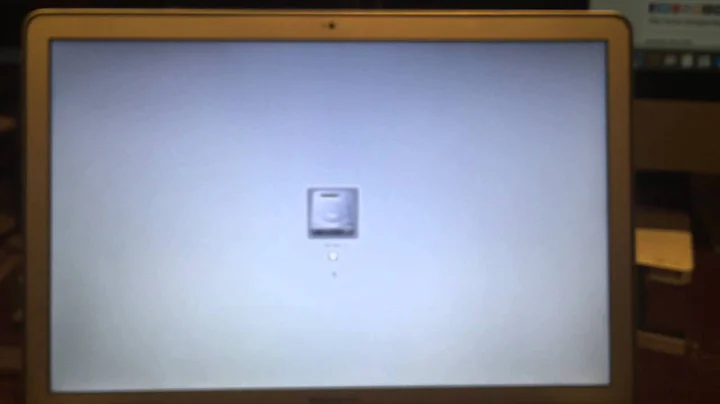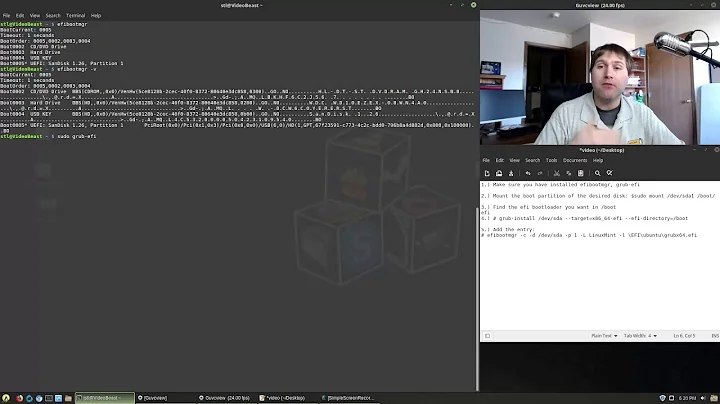EFI settings set via efibootmgr are ignored after reboot
Solution 1
You're seeing a bug, and it's almost certainly not related to Secure Boot. I have several suggestions, but none is guaranteed to fix the problem:
- Update your firmware -- If the bug is in the firmware, updating it may fix the problem. Check with the computer's (or motherboard's) manufacturer to find updates. (They're probably called "BIOS updates," although technically your firmware is not a BIOS.) After the update, reboot into Linux and try again.
- Reset your firmware to its default settings -- Sometimes EFI boot manager lists become corrupted, causing symptoms like those you describe. Resetting all the firmware settings to their defaults in the setup utility may fix this problem. Unfortunately, this step will remove any working boot manager entries, so you may need to use an emergency tool (such as my rEFInd boot manager on a USB drive or CD-R) to boot until you re-create your working entries.
-
Delete unused boot manager entries -- Deleting unused boot manager entries (with the
-Boption toefibootmgr) can also work around corrupted entries. Tryefibootmgralone, orefibootmgr -vfor more verbose output, to locate duplicate or unwanted entries. (Note that the firmware may re-create some automatically when you reboot. This may happen with network boot options or options to boot external media, for instance.) -
Use another tool to create the boot entry -- Sometimes
efibootmgrdoesn't work but a tool in another OS (likebcdeditor EasyUEFI in Windows) or thebcfgtool in an EFI shell will get the job done. Thus, you might try these tools instead ofefibootmgr. -
Use a fallback filename -- The fallback filename (
EFI/BOOT/bootx64.efion x86-64 systems) can be used if nothing else is working; however, this filename will typically be the last one a computer tries to boot. Thus, if it's already booting via some other name (like the Windows boot loader,EFI/Microsoft/Boot/bootmgfw.efi), you may need to back that up, rename your desired boot manager/loader to the currently-booting default, and reconfigure the new boot loader to offer to boot the one it's masquerading as using its new name. This is a bit of a juggling act at best, and not all EFI boot loaders for Linux can chainload to another EFI program, so it may not work properly. (I don't recall offhand if SYSLINUX can chainload another EFI program.) - Switch to BIOS/CSM/legacy booting -- Most EFIs provide a Compatibility Support Module (CSM), which enables them to boot BIOS-mode boot loaders. Thus, you can install a BIOS-mode boot loader for Linux, activate the CSM, and boot in this way. If you're dual-booting another OS, though, you'll need to install its BIOS-mode boot loader, too, and this may necessitate changing from GPT to MBR partitioning. Overall, this approach is likely to be a bit of a pain; but on some EFIs (mostly old ones from 2011 or thereabouts), it may be the best approach.
- Return the computer for a refund -- If all else fails, and if the computer is within its store return period, you can return it for one that works. In fact, I recommend this approach before either of the preceding two options, if possible. If you do this, be sure to contact the manufacturer to tell them why you returned the computer. EFIs have had serious bugs from Day One, and some manufacturers have been slow to fix them, in part because their customers never complain, so the manufacturers don't realize how serious the bugs are.
Solution 2
Like the OP, I was seeing old, invalid entries when using efibootmgr. I tried to remove them with the -B option, and it appeared to work, but on reboot, the old list would be back and my changes lost.
The solution for me, on a Thinkpad, was to go into BIOS Setup and set "Boot Order Lock" on the Boot tab to Disabled. When it is Enabled you cannot modify the boot entries. Hope this helps someone else out!
Solution 3
UPDATE:
Hi there, me again,
started to work on it again, now fixed with renaming the .efi file to the windows equivalent (bootmgfw.efi), then remounted the efivar file system efivarfs like in the above description, then set the uefi boot entry in the VRAM by typing
efibootmgr -c -d /dev/sda -p 4 -L "linuxmint_grub" -l "\EFI\linuxmint_grub\bootmgfw.efi"
with having the ESP on /dev/sda, partition 4.
No booting works flawlessly, efibootmgr entry remains persistently, only drawback: GRUB starting up at boot time automatically despite having it turned off. Seems to be a GRUB issue, gonna fix that later.
Cheers and hope I could help ;)
Related videos on Youtube
Misaz
Updated on September 18, 2022Comments
-
 Misaz over 1 year
Misaz over 1 yearI have 2 disks (/dev/sda and /dev/sdb) on UEFI laptop. Both GPT.
sda1 - NTFS - Windows, sda2 - FAT32 - EFI partition where is Windows Boot Manager and GRUB sdb1 - NTFS - another windows sdb2 - NTFS - My data sdb3 - FAT32 - EFI partition sdb4 - EXT4 - Debianin EFI order i can see Windows Boot Manager and GRUB. I can change between then and thats working. I consider to use syslinux to boot to debian. I want to have syslinux on sdb3, I mounted that and copy these files to this partition at the location:
/EFI/SYSLINUX/initrd.img /EFI/SYSLINUX/ldlinux.e64 /EFI/SYSLINUX/syslinux.cfg /EFI/SYSLINUX/syslinux.efi /EFI/SYSLINUX/vmlinuzvmlinuz and initrd i copied from sdb4\boot and rename. syslinux.efi and ldlinux.e64 i copied from syslinux-6.03.tar.gz downloaded from http://kernel.org. syslinux.cfg i wrote and contents is
PROMPT 0 TIMEOUT 300 DEFAULT deb LABEL deb LINUX vmlinuz APPEND ROOT=/dev/sdb4 INITRD initrd.imgthen i added record to EFI via command
efibootmgr -c -d /dev/sdb3 -p 1 -l \\EFI\\SYSLINUX\\syslinux.efi -L "SYSLINUX2"efiboot manager responded success and shows SYSLINUX2 as boot options but when i reboot computer (by reboot command) and goes to UEFI settings, there is no SYSLINUX2 option added. There are only GRUB and Windows Boot Manager. After next boot to debian, efibootmgr too responses only Windows Boot Manager and GRUB.
I have read that some people had problems with secure boot. I have disabled it and GRUB have not problem with this.
What is wrong? How to make efibootmgr setting persistent? Where i did mistake (if any)?
-
Rod Smith over 7 yearsIf EasyUEFI works and
efibootmgrdoesn't, please report this as a bug to your distribution. Include your exact computer make and model number and the exact kernel andefibootmgrversions in your bug report. Bugs like this can only be corrected if developers know about them. -
 Misaz over 7 yearsAfter some experiment i think that main bug is in uefi, because EasyUEFI sometimes fails in modifiing and deleting entries and sometimes overrides another settings. For example yesterday when i was changing boot order it exchanges settings with GRUB. Entry named GRUB was starting Windows and entry named Windows Boot Manager was starting GRUB.
Misaz over 7 yearsAfter some experiment i think that main bug is in uefi, because EasyUEFI sometimes fails in modifiing and deleting entries and sometimes overrides another settings. For example yesterday when i was changing boot order it exchanges settings with GRUB. Entry named GRUB was starting Windows and entry named Windows Boot Manager was starting GRUB. -
Rod Smith over 7 yearsIf EasyUEFI sometimes works and sometimes fails, but if
efibootmgralways fails, then that suggests a difference between EasyUEFI/Windows andefibootmgr/Linux, which might be considered a bug, so it's still worth reporting. Either way, it's worth reporting it as a bug to the computer's manufacturer, although I recommend updating to the latest firmware version first. (This might cause all boot entries to be deleted, so be prepared to recover them.) -
 Jamie Scott over 2 yearsI must have just spent hours trying to work out why my Thinkpad wouldn't boot and why changes made using
Jamie Scott over 2 yearsI must have just spent hours trying to work out why my Thinkpad wouldn't boot and why changes made usingefibootmgrwouldn't stick and this was it. There should be a fat warning label in Linux installers prompting to check this is disabled before install!




